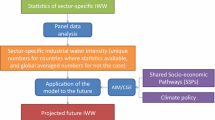Abstract
With ever increasing water demands and the continuous intensification of water scarcity arising from China’s industrialization, the country is struggling to harmonize its industrial development and water supply. This paper presents a systems analysis of water withdrawals by Chinese industry and investigates demand-driven industrial water uses embodied in final demand and interregional trade based on a multi-regional input-output model. In 2007, the Electric Power, Steam, and Hot Water Production and Supply sector ranks first in direct industrial water withdrawal (DWW), and Construction has the largest embodied industrial water use (EWU). Investment, consumption, and exports contribute to 34.6%, 33.3%, and 30.6% of the national total EWU, respectively. Specifically, 58.0%, 51.1%, 48.6%, 43.3%, and 37.5% of the regional EWUs respectively in Guangdong, Shanghai, Zhejiang, Jiangsu, and Fujian are attributed to international exports. The total interregional import/export of embodied water is equivalent to about 40% of the national total DWW, of which 55.5% is associated with the DWWs of Electric Power, Steam, and Hot Water Production and Supply. Jiangsu is the biggest interregional exporter and deficit receiver of embodied water, in contrast to Guangdong as the biggest interregional importer and surplus receiver. Without implementing effective water-saving measures and adjusting industrial structures, the regional imbalance between water availability and water demand tends to intensify considering the water impact of domestic trade of industrial products. Steps taken to improve water use efficiency in production, and to enhance embodied water saving in consumption are both of great significance for supporting China’s water policies.
Similar content being viewed by others
References
Cai Z F, Yang Q, Zhang B, Chen H, Chen B, Chen G Q (2009). Water resources in unified accounting for natural resources. Commun Nonlinear Sci Numer Simul, 14(9–10): 3693–3704
Cazcarro I, Duarte R, Sánchez-Chóliz J (2013). Multiregional input-output model for the evaluation of Spanish water flows. Environ Sci Technol, 47(21): 12275–12283
Chen G Q, Chen Z M (2010). Carbon emissions and resources use by Chinese economy 2007: a 135-sector inventory and input-output embodiment. Commun Nonlinear Sci Numer Simul, 15(11): 3647–3732
Chen G Q, Chen Z M (2011). Greenhouse gas emissions and natural resources use by the world economy: ecological input-output modeling. Ecol Modell, 222(14): 2362–2376
Chen G Q, Zhang B (2010). Greenhouse gas emissions in China 2007: inventories and input-output analysis. Energy Policy, 38(10): 6180–6193
Chen Z M, Chen G Q (2013a). Demand-driven energy requirement of world economy 2007: a multi-region input-output network simulation. Commun Nonlinear Sci Numer Simul, 18(7): 1757–1774
Chen Z M, Chen G Q (2013b). Virtual water accounting for the globalized world economy: national water footprint and international virtual water trade. Ecol Indic, 28: 142–149
Chen Z M, Chen G Q, Xia X H, Xu S Y (2012). Global network of embodied water flow by systems input-output simulation. Front Earth Sci, 6(3): 331–344
Chen Z M, Chen G Q, Zhou J B, Jiang M M, Chen B (2010). Ecological input-output modeling for embodied resources and emissions in Chinese economy 2005. Commun Nonlinear Sci Numer Simul, 15(7): 1942–1965
Cheng H, Hu Y (2011). Economic transformation, technological innovation, and policy and institutional reforms hold keys to relieving China’s water shortages. Environ Sci Technol, 45(2): 360–361
CSY (2008). China Statistical Yearbook 2008. Also available at:http://www.stats.gov.cn/tjsj/ndsj/2008/indexch.htm
CSY (2009). China Statistical Yearbook 2009. Also available at: http://www.stats.gov.cn/tjsj/ndsj/2009/indexch.htm
Dong H, Geng Y, Sarkis J, Fujita T, Okadera T, Xue B (2013). Regional water footprint evaluation in China: a case of Liaoning. Sci Total Environ, 442: 215–224
Feng K, Davis S J, Sun L, Li X, Guan D, Liu W, Liu Z, Hubacek K (2013). Outsourcing CO2 within China. Proc Natl Acad Sci USA, 110(28): 11654–11659
Feng K, Hubacek K, Minx J, Siu Y L, Chapagain A, Yu Y, Guan D, Barrett J (2011). Spatially explicit analysis of water footprints in the UK. Water, 3(1): 47–63
Feng K, Siu Y L, Guan D, Hubacek K (2012). Assessing regional virtual water flows and water footprints in the Yellow River Basin, China: a consumption based approach. Appl Geogr, 32(2): 691–701
Gu A, Teng F, Wang Y (2014). China energy-water nexus: assessing the water-saving synergy effects of energy-saving policies during the eleventh Five-year Plan. Energy Convers Manage, 85: 630–637
Guan D, Hubacek K (2007). Assessment of regional trade and virtual water flows in China. Ecol Econ, 61(1): 159–170
Guan D, Hubacek K (2008). A new and integrated hydro-economic accounting and analytical framework for water resources: a case study for North China. J Environ Manage, 88(4): 1300–1313
Hoekstra A Y, Chapagain A K (2007). Water footprints of nations: water use by people as a function of their consumption pattern. Water Resour Manage, 21(1): 35–48
Hu Y, Cheng H (2013). Water pollution during China’s industrial transition. Environmental Development, 8: 57–73
Hubacek K, Guan D, Barrett J, Wiedmann T (2009). Environmental implications of urbanization and lifestyle change in China: ecological and water footprints. J Clean Prod, 17(14): 1241–1248
Lenzen M, Moran D, Bhaduri A, Kanemoto K, Bekchanov M, Geschke A, Foran B (2013). International trade of scarce water. Ecol Econ, 94: 78–85
Lin C, Suh S, Pfister S (2012). Does South-to-North water transfer reduce the environmental impact of water consumption in China? J Ind Ecol, 16(4): 647–654
Lindner S, Liu Z, Guan D, Geng Y, Li X (2013). CO2 emissions from China’s power sector at the provincial level: consumption versus production perspectives. Renew Sustain Energy Rev, 19: 164–172
Liu WD, Chen J, Tang Z P, Liu H G, Han D, Li F Y (2012). Compliment Theory and Practice of China’s Interregional Input-output Table for 30 Regions in 2007. Beijing: China Statistics Press (in Chinese)
Llop M (2013). Water reallocation in the input-output model. Ecol Econ, 86: 21–27
Meng B, Xue J, Feng K, Guan D, Fu X (2013). China’s inter-regional spillover of carbon emissions and domestic supply chains. Energy Policy, 61: 1305–1321
Meng L, Guo J, Chai J, Zhang Z (2011). China’s regional CO2 emissions: characteristics, inter-regional transfer and emission reduction policies. Energy Policy, 39(10): 6136–6144
Ministry of Water Resources (2008). China Water Resources Bulletin 2007. Beijing: China Water Resources & Hydropower Press
Ministry of Water Resources (2012). China Water Resources Bulletin 2011. Beijing: China Water Resources & Hydropower Press
Mubako S, Lahiri S, Lant C (2013). Input-output analysis of virtual water transfers: case study of California and Illinois. Ecol Econ, 93: 230–238
National Bureau of Statistics (2010). China Economic Census Yearbook 2008. Beijing: China Statistics Press
Okadera T, Watanabe M, Xu K (2006). Analysis of water demand and water pollutant discharge using a regional input-output table: an application to the City of Chongqing, upstream of the Three Gorges Dam in China. Ecol Econ, 58(2): 221–237
Pan L, Liu P, Ma L, Li Z (2012). A supply chain based assessment of water issues in the coal industry in China. Energy Policy, 48: 93–102
Su B, Ang B W (2014). Input-output analysis of CO2 emissions embodied in trade: a multi-region model for China. Appl Energy, 114: 377–384
Tian X, Chang M, Lin C, Tanikawa H (2014). China’s carbon footprint: a regional perspective on the effect of transitions in consumption and production patterns. Appl Energy, 123: 19–28
Varbanov P S (2014). Energy and water interactions: implications for industry. Current Opinion in Chemical Engineering, 5: 15–21
Wang W, Gao L, Liu P, Hailu A (2014). Relationships between regional economic sectors and water use in a water-scarce area in China: a quantitative analysis. J Hydrol (Amst), 515: 180–190
Wang Y, Xiao H L, Lu MF (2009). Analysis of water consumption using a regional input-output model: model development and application to Zhangye City, Northwestern China. J Arid Environ, 73(10): 894–900
Wang Y Y, Wang H X, Zhang X (2013a). China water footprint trend analysis based on input-output tables. Acta Ecol Sin, 33(11): 3488–3498
Wang Z, Huang K, Yang S, Yu Y (2013b). An input-output approach to evaluate the water footprint and virtual water trade of Beijing, China. J Clean Prod, 42: 172–179
Wiedmann T (2009). A review of recent multi-region input-output models used for consumption-based emission and resource accounting. Ecol Econ, 69(2): 211–222
Wiedmann T, Wilting H C, Lenzen M, Lutter S, Palm V (2011). Quo Vadis MRIO? Methodological, data and institutional requirements for multi-region input-output analysis. Ecol Econ, 70(11): 1937–1945
Yang H, Pfister S, Bhaduri A (2013). Accounting for a scarce resource: virtual water and water footprint in the global water system. Current Opinion in Environmental Sustainability, 5(6): 599–606
Zhang B, Chen Z M, Xia X H, Xu X Y, Chen Y B (2013). The impact of domestic trade on China’s regional energy uses: a multi-regional input-output modeling. Energy Policy, 63: 1169–1181
Zhang B, Li J S, Peng B H (2014a). Multi-regional input-output analysis for China’s regional CH4 emissions. Front Earth Sci, 8(1): 163–180
Zhang C, Anadon L D (2013). Life cycle water use of energy production and its environmental impacts in China. Environ Sci Technol, 47(24): 14459–14467
Zhang C, Anadon L D (2014). A multi-regional input-output analysis of domestic virtual water trade and provincial water footprint in China. Ecol Econ, 100: 159–172
Zhang Y, Wang H, Liang S, Xu M, Liu W, Li S, Zhang R, Nielsen C P, Bi J (2014b). Temporal and spatial variations in consumption-based carbon dioxide emissions in China. Renew Sustain Energy Rev, 40: 60–68
Zhang Z, Yang H, Shi M J (2011a). Analyses of water footprint of Beijing in an interregional input-output framework. Ecol Econ, 70(12): 2494–2502
Zhang Z, Yang H, Shi M J, Zehnder A J B, Abbaspour K C (2011b). Analyses of impacts of China’s international trade on its water resources and uses. Hydrol Earth Syst Sci, 15(9): 2871–2880
Zhao X, Chen B, Yang Z F (2009). National water footprint in an inputoutput framework-A case study of China 2002. Ecol Modell, 220(2): 245–253
Zhao X, Yang H, Yang Z F, Chen B, Qin Y (2010). Applying the inputoutput method to account for water footprint and virtual water trade in the Haihe River Basin in China. Environ Sci Technol, 44(23): 9150–9156
Zhong Z, Huang R, Tang Q, Cong X, Wang Z (2015). China’s provincial CO2 emissions embodied in trade with implications for regional climate policy. Front Earth Sci, 9(1): 77–90
Author information
Authors and Affiliations
Corresponding authors
Rights and permissions
About this article
Cite this article
Zhang, B., Chen, Z.M., Zeng, L. et al. Demand-driven water withdrawals by Chinese industry: a multi-regional input-output analysis. Front. Earth Sci. 10, 13–28 (2016). https://doi.org/10.1007/s11707-015-0505-8
Received:
Accepted:
Published:
Issue Date:
DOI: https://doi.org/10.1007/s11707-015-0505-8




